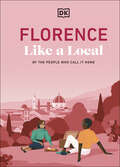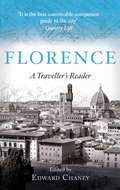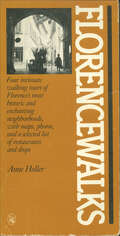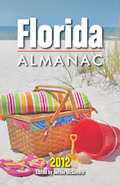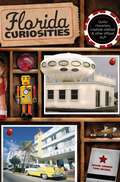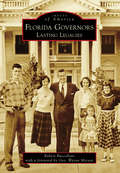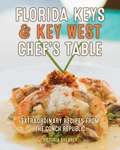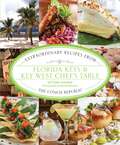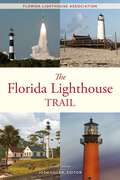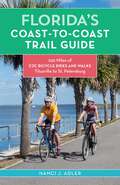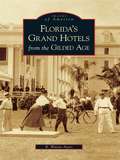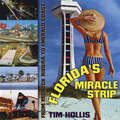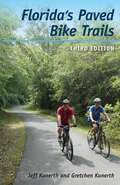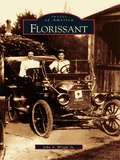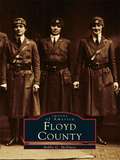- Table View
- List View
Florence Like a Local: By the People Who Call It Home (Local Travel Guide)
by DK TravelKeen to explore a different side of Florence? Like a Local is the book for you.This isn’t your ordinary travel guide. Beyond the Renaissance treasures that define the city, you'll find hidden dive bars, community gardens and mini basement galleries hosting fashion events – and that’s where this book takes you. Turn the pages to discover:- The small businesses and community strongholds that add character to this vibrant city, recommended by true locals.- 6 themed walking tours dedicated to specific experiences such as street food and swimming pots.- A beautiful gift book for anyone seeking to explore Florence.- Helpful ‘what3word’ addresses, so you can pinpoint all the listed sights.Compiled by three proud locals, this stylish travel guide is packed with Florence’s best experiences and secret spots, handily categorized to suit your mood and needs.Whether you’re a restless Florentine on the hunt for a new hangout, or a visitor keen to discover a side you won’t find in traditional guidebooks, Florence Like A Local will give you all the inspiration you need. About Like A Local:These giftable and collectible guides from DK Eyewitness are compiled exclusively by locals. Whether they’re born-and-bred or moved to study and never looked back, our experts shine a light on what it means to be a local: pride for their city, community spirit and local expertise. Like a Local will inspire readers to celebrate the secret as well as the iconic – just like the locals who call the city home. Looking for another guide to Florence? Explore further with our DK Eyewitness or Top 10 guides to Florence.
Florence Revisited (Images of America)
by Florence Historical Society Book CommitteeKnown as "the Community with Character at the Bend in the River," Florence has a fascinating past and rich heritage. First inhabited by the Lenni-Lenape tribes, Florence is believed to be named after the daughter of Charles Macalester of Philadelphia, one of the area's first landowners who was instrumental in dividing Florence into lots for future homes in the early 1850s. Some early residents were decoy carvers, whose labors are in high demand today under the classification of Delaware River decoys, while others worked in foundries or as storekeepers, farmers, and fishermen. Picking up where Florence left off, Florence Revisited will provide information and enjoyment for those who are proud to call this town home, and it will spark an interest for old pictures, stories, and news articles about early families in Florence, New Jersey.
Florence: A Traveller's Reader
by Harold Acton Edward ChaneyOf all Italian cities, Florence has always had the strongest English accent: the Goncourt brothers in 1855 called it 'ville tout anglaise'. Though that accent is diminished now, Florence remains for the English-speaking traveller what it always has been - one of the best loved, and most visited, of cities.In this Traveller's Reader, Florence's rich and glorious past is brought vividly to life for the tourist of today through the medium of letters, diaries and memoirs of travellers to Florence from past centuries and of the Florentines themselves. The extracts chosen include: Boccaccio on the Black Death; Vasari on the building of Giotto's Campanile; an eye-witness account of the installation of Michaelangelo's 'David'; the death of Elizabeth Barrett Browning at the Casa Guidi; and D. H. Lawrence and Dylan Thomas on twentieth-century Florentine society. Sir Harold Acton provides a concise history of the city from its origins, through its zenith as a prosperous city state which, under the Medici, gave birth to the Renaissance, and up to the Arno's devastating flood in 1966. Sir Harold Acton, man of letters, historian, aesthete, novelist and poet, has spent most of his life in Florence. Among his best-known books is The Last Medici, Memoirs of an Aesthete.
Florence: A Traveller's Reader
by Edward ChaneyOf all Italian cities, Florence has always had the strongest English accent: the Goncourt brothers in 1855 called it 'ville tout anglaise'. Though that accent is diminished now, Florence remains for the English-speaking traveller what it always has been - one of the best loved, and most visited, of cities.In this Traveller's Reader, Florence's rich and glorious past is brought vividly to life for the tourist of today through the medium of letters, diaries and memoirs of travellers to Florence from past centuries and of the Florentines themselves. The extracts chosen by cultural historain Edward Chaney include: Boccaccio on the Black Death; Vasari on the building of Giotto's Campanile; an eye-witness account of the installation of Michaelangelo's 'David'; the death of Elizabeth Barrett Browning at the Casa Guidi; and D. H. Lawrence and Dylan Thomas on twentieth-century Florentine society. Sir Harold Acton's introduction provides a concise history of the city from its origins, through its zenith as a prosperous city state which, under the Medici, gave birth to the Renaissance, and up to the Arno's devastating flood in 1966. Sir Harold Acton, man of letters, historian, aesthete, novelist and poet, spent most of his life in Florence. Among his best-known books is The Last Medici, Memoirs of an Aesthete.Currently Professor of Fine and Decorative Arts at Southampton Solent University, Edward Chaney is an honorary life member of the British Institute of Florence and taught at the University of Pisa for six years.
Florencewalks
by Anne HollerMuch of Florence's art is not in her world-famous museums but in her streets, and those treasures can only be seen by those who explore this lovely, medieval city on foot. The four intimate walking tours in Florencewalks lead you through centuries of Italian history and architecture--around corners that hide marble gods and goddesses, down hushed alleys pervaded by the aroma of spices and pastas, out onto sun-washed piazzas flanked by churches and palazzos and open-air markets. Easily completed in a morning of afternoon, each walk includes plenty of spots along the way to sit and read, rest, or browse. In addition to maps of each walk, and more than thirty photographs, Florencewalks also contains a detailed section of visitor information and advice, a concise chronology of the city's history, an index, and a list of particularly special trattorias, wine bars, and shops.
Florentine Palaces and Their Stories [Illustrated Edition]
by Janet RossRoss tells the story behind almost 100 palaces in the Florentine region including Palazzo Acciaiuoli; Palazzo Altoviti; Palazzo Corsini, Palazzo Podesta; and many more. A fascinating overview of dozens of palaces in Florence complete with the original illustrations.
Florida Almanac, 2012
by Bernie McGovernAn amazing atlas, directory, tourist guide, reference manual, and history book all in one—for natives, visitors, and new residents in the Sunshine State! From basic history and tourist information to obscure facts—such as the size of the largest squash grown—this book has it all. After reading the list of derivatives for the name of each Florida county, the Lake City Reporter called a previous edition of this book &“indispensable&” and described it as containing &“just about everything you ever wanted to know about Florida—and a good deal of information you probably never really thought about.&” In addition to listings of national memorials, monuments, and landmarks, this volume contains road maps of each county, charts of rivers and waterways, and facts about Florida&’s geography and climate. For those who are visiting the state, there are sections on major attractions, annual festivals, state parks, and lodging as well as regulations for boating, fishing, and hunting. The chapters on education, crime, residency, taxes, and utilities will be invaluable to people who are considering moving to Florida. Anyone interested in the history and settlement of the Sunshine State will appreciate the facts about Native American cultures and the chronology of major events in Florida&’s past. Also included are various statistics and a hurricane survival guide. Packed with information and including a detailed index, it&’s a useful, comprehensive reference—and a fascinating resource for geography lovers.
Florida Breweries (Breweries Series)
by Gerard WalenThe craft brew revolution has spread south. This all-new guidebook profiles the Sunshine State's 66 breweries and brewpubs.
Florida Curiosities (Curiosities Series)
by David Grimes Tom BecnelWhether you&’re a born-and-raised Floridian, a recent transplant, or just passing through, Florida Curiosities will have you laughing out loud as David Grimes and Tom Becnel take you on a rollicking tour of the strangest sides of the Sunshine State. Discover the state&’s smallest police station; its highest point (at a measly 345 feet); and its warmest (and smelliest) mineral spring.Meet a worm-fiddlin&’ woman; a chainsaw-wieldin&’ man; and some real-life underwater dancing mermaids—sure to make a splash with the little ones!Join the fun at a flip-your-own-pancake restaurant; the Chumuckla Redneck Parade&’s lack-of-beauty pageant; or the get-nekked-if-you-dare Butt Hutt.
Florida Governors: Lasting Legacies
by Gov. Wayne Mixson Robert BuccellatoThe state of Florida has a unique place in the annals of national history and has been a constant contributor to the country's identity. The 51 men who have served as the state's governors are an essential part of its complex identity and have produced resonant material for historians of all ages. They have been farmers, generals, boat captains, restaurant owners, presidents, and sons of presidents. They have been given the office by both popular mandate and the happenstance of fate. These individuals have represented virtually every category of what it means to be a Floridian. Their lasting legacies can be felt every day by the state's citizens. Since the drainage of the Everglades and the transformation of swamplands into beachfront paradises, Florida has lured Americans from various states to its sunny shores. It has seceded from the Union, determined the final verdict in many presidential elections, was the site of railroad monopolies, developed into a playground of the rich, and is the birthplace of a new kind of theme park--all while being led by these distinct individuals who, at their core, were Floridians first.
Florida Keys & Key West Chef's Table: Extraordinary Recipes from the Conch Republic
by Victoria ShearerSurrounded by water, the Florida Keys yields a bounty that easily could qualify as the eighth wonder of the world. The Keys can confidently boast that nowhere else in the continental US will you find fresher, more innovatively prepared fish and seafood. Special natural resources, from stone crabs and yellowtail snapper to cracked conch and key limes, are served any way you like and the relaxed atmosphere of the restaurants is reflected in the cuisine. Be it a roadside cafe or a resort dining room, the cuisine is all &“Keys casual.&” With recipes for the home cook from Florida's most celebrated eateries and showcasing over 200 full-color photos featuring mouth-watering dishes, famous chefs, and lots of local flavor, Florida Keys & Key West Chef's Table is the ultimate gift and keepsake cookbook for both tourists and residents of the Keys.
Florida Keys & Key West Chef's Table: Extraordinary Recipes from the Conch Republic (Chef's Table)
by Victoria ShearerSurrounded by water, the Florida Keys yields a bounty that easily could qualify as the eighth wonder of the world. The Keys can confidently boast that nowhere else in the continental US will you find fresher, more innovatively prepared fish and seafood. Special natural resources, from stone crabs and yellowtail snapper to cracked conch and key limes, are served any way you like and the relaxed atmosphere of theS restaurants is reflected in the cuisine. Be it a roadside cafe or a resort dining room, the cuisine is all &“Keys casual.&”
Florida Keys Paddling Atlas (Paddling Series)
by Bill Burnham Mary BurnhamThe Florida Keys Paddling Atlas, a first of its kind detailed color atlas of the Florida Keys, from Key Largo to Key West, is specifically designed for paddlers, fly fishers, snorkelers, and other small craft water enthusiasts interested in shallow water exploration. Color charts for this atlas are fully annotated with key put-ins, take-outs, paddle friendly marinas, hidden waterways, bird watching, fishing spots, surf spots, and more. Other narrative information, including descriptive commentary, natural history, flora and fauna, and points of interest will be presented and referenced in order to guide water travelers on their own excursions and adventures.
Florida Lighthouse Trail
by Chris Belcher Josh Liller Florida Lighthouse AssociationFrom Amelia Island to the Keys to Pensacola in the Panhandle, the coast of Florida is dotted with lighthouses of all sizes, shapes, materials, and - best of all – histories. The Florida Lighthouse Trail is a compilation of short histories, written by expert contributors from around the state. Each chapter has fascinating details about these great sentinels. Chock-full of information on dates of construction and operation, changes over time, and Fresnel lenses, this book also serves as a travel guide with directions and contact information for their support organizations. Paul Bradley's beautiful artwork richly illustrates each lighthouse. This new edition features substantially updated information, with the most up-to-date information for history buffs and prospective visitors. The Florida Lighthouse Trail also includes a history of the Florida Lighthouse Association, an extensive glossary, short biographies of the contributors, suggested reading, and an index.
Florida Lighthouses
by John HairrSporting the second-longest coastline in the United States, Florida has over 8,000 miles of sparkling beaches and waterfront property. This valuablelandscape and the region's position between the Atlantic Ocean and the Gulf of Mexico made Florida key in the early expansion of American trade routes, but the state's several capes and dangerous reefs, rocks, and shoals made travel quite perilous to unwary mariners. When commerce and traffic began to grow between ports on the East Coast and along the Gulf of Mexico in the nineteenth century, it became necessary to construct aids to navigation along the state's long and treacherous coast. Lighthouses were the solution. Constructed in a variety of styles and sizes, Florida's lighthouses were erected on what, at the time, were some of the most desolate regions of the southeastern United States and included lonely offshore islands. Manned and inhabited by vigilant keepers and their families, these towers illuminated the dark seas and provided the beacon that guided lost travelers. Large brick structures watched over St. Augustine, Pensacola, and Ponce de Leon Inlet; iron skeletons towered over Crooked River and Hillsboro Inlet; and screwpile lighthouses stood as sentinels in the waters off the Florida Keys.
Florida Off the Beaten Path®: Discover Your Fun (Off the Beaten Path Series)
by Jackie Sheckler Finch Diana Gleasner Bill GleasnerWhether you&’re a visitor or a local looking for something different, Florida Off the Beaten Path shows you the Sunshine State with new perspectives on timeless destinations and introduces you to those you never knew existed––from the best in local dining to quirky cultural tidbits to hidden attractions, unique finds, and unusual locales.
Florida's Coast-to-Coast Trail Guide: 250-Miles of C2C Bicycle Rides and Walks- Titusville to St. Petersburg
by Nanci AdlerFlorida's Coast-to-Coast Trail Guide is a guidebook designed specifically for the 250-mile dedicated bicycle/pedestrian trail that provides an uninterrupted cross-Florida trail from Titusville to St. Petersburg. The trail (over 80% complete and to be completed by 2025) already attracts not only local cyclists and walkers, but also out-of-state cycling enthusiasts. This book provides readers with a broad background of the communities through which they will travel. Although maps are included, this is not a detailed "how-to" guide, nor does it provide extensive lodging, camping or restaurant information; much of that information changes frequently and can be easily obtained via online searches. Instead, this book focuses on interesting cultural and natural aspects of the route. By highlighting the local flavor of small towns, the beauty of natural Florida, as well as local historical events, this book will introduce readers to the uniqueness of Florida. Distinctive features covered in the book include the Greek heritage of Tarpon Springs, Winter Garden's thriving downtown based on its citrus and bass-fishing past, Titusville's role in space exploration, and St. Petersburg&’s lively waterfront and flourishing art scene. Also covered is the natural world of beautiful freshwater springs, moss-shrouded oak trees, and migratory birds found in protected areas along the trail such as Gemini Springs Park, Brooker Creek Preserve and the Green Swamp. In addition, readers will be introduced to important historical Florida figures such as civil rights leaders Harry T. and Harriett V. Moore and Russian entrepreneur and railway builder Peter Demens.
Florida's Grand Hotels from the Gilded Age
by R. Wayne AyersFlorida in the late 1800s was a paradise waiting to be discovered. During this period, two visionary tycoons of the Gilded Age set out on separate ventures that would transform the Sunshine State from America's last frontier into a destination for the rich and famous. The grand hotels that Henry M. Flagler and Henry B. Plant opened at their planned resort sites offered a fantasy stay surrounded by all the accoutrements expected by sophisticated, Gilded Age patrons. Florida's Grand Hotels from the Gilded Age provides a look at these magnificent structures during their glory years, along with the fashionable entertainment and social and recreational pastimes that engaged their gilded guests.
Florida's Miracle Strip: From Redneck Riviera to Emerald Coast
by Tim HollisSince World War II, tourists have flocked to Florida's northwest Gulf Coast and sun and fun spots at Panama City Beach, Fort Walton Beach, and Pensacola Beach. Every year those visitors number in the millions. For those who long to recall how the vacationland appeared thirty, forty, or even fifty years ago, Tim Hollis has written Florida's Miracle Strip: From Redneck Riviera to Emerald Coast. In a style that informs and entertains, Hollis describes the rise of early developments, such as Long Beach Resort, and major tourist attractions, such as the Gulfarium and the Miracle Strip Amusement Park. With heartfelt nostalgia and a dose of tongue-in-cheek, he reminisces on the motels and tourist cottages; the restaurants, such as Captain Anderson's and Staff's; the elaborate miniature golf courses, such as Goofy Golf and its many imitators. He takes a special delight in recovering the memories of those quirky businesses that now exist only in faded photographs and aging postcards, such wacky tourist traps as Castle Dracula, Petticoat Junction, Tombstone Territory, and the Snake-A-Torium. In the book, Hollis examines how this area became known as the "Miracle Strip," and how the local chambers of commerce got so tired of that image that the name gradually fell into disuse. The book is illustrated with a profusion of vintage photos and advertisements, most of which have not been seen in print since their original appearances. For the nostalgia lover, the snowbird, the tourist seeking yesteryear, Florida's Miracle Strip: From Redneck Riviera to Emerald Coast will be a welcome traveling companion.
Florida's Paved Bike Trails
by Jeff Kunerth Gretchen KunerthSince the release of the first edition of Florida’s Paved Bike Trails, the Sunshine State has added more than 200 miles of multiuse asphalt and concrete paths. This updated edition of the best-selling guide to bicycling in Florida adds twenty-three new trails to an already impressive roster, offering cyclists—as well as rollerbladers, joggers, and walkers—vital details on over sixty trails across Florida. From where to find parking, water, restrooms, and benches, to how to reach nearby beaches, restaurants, museums, and other attractions, the authors expertly guide readers through Florida’s beautiful terrain.
Florida's Rivers: A Celebration of Over 40 of the Sunshine State's Dynamic Waterways
by Doug AldersonThe rivers in Florida are steeped in a rich natural and cultural history. They are avenuesthrough time, allowing us to wrap ourselves in a rich historical tapestry, and they are showcases for wildlife and natural beauty. On some rivers, idyllic scenes are revealed bend after bend for miles and sometimes days, appearing to have changed little since early native people plied the waters in dugout canoes.Imagine gliding along a clear watercourse beneath a leafy canopy of maple, cypress, and gum. The current swirls eelgrass in undulating patterns as schools of silvery mullet shoot past. Ahead, a manatee&’s snout breaks the surface in a loud whoosh, its gray body lumbering slowly along and showing little fear as you pass by. A red-shouldered hawk cries and soars over treetops while a black anhinga stretches long wings to dry while perched on a cypress knee.Whether you are viewing a river from the land or, especially, a kayak, canoe, or paddleboard, let Florida's Rivers be your guide to celebrating the state's treasures.
Florissant
by John A. Wright Sr.The first civil government in Florissant was established in 1786, three years before the United States adopted its constitution and George Washington was elected the country's first president. French farmers and fur trappers looked upon the land and called it the "Valle Fleurissant"-which is to say, "the flowering or fertile valley." The community remained small until after World War II. Between 1950 and 1980, the population grew from 3,737 to 76,754. Today the community strives to preserve its proud heritage and build on the strength of its diverse population. The historic images in this book illustrate the city's founding and development, from the first French settlers to the post World War II building boom to the exciting new city of today.
Flowers, Guns, and Money: Joel Roberts Poinsett and the Paradoxes of American Patriotism (American Beginnings, 1500-1900)
by Lindsay Schakenbach RegeleA fascinating historical account of a largely forgotten statesman, who pioneered a form of patriotism that left an indelible mark on the early United States. Joel Roberts Poinsett’s (1779–1851) brand of self-interested patriotism illuminates the paradoxes of the antebellum United States. He was a South Carolina investor and enslaver, a confidant of Andrew Jackson, and a secret agent in South America who fought surreptitiously in Chile’s War for Independence. He was an ambitious Congressman and Secretary of War who oversaw the ignominy of the Trail of Tears and orchestrated America’s longest and costliest war against Native Americans, yet also helped found the Smithsonian. In addition, he was a naturalist, after whom the poinsettia—which he appropriated while he was serving as the first US ambassador to Mexico—is now named. As Lindsay Schakenbach Regele shows in Flowers, Guns, and Money, Poinsett personified a type of patriotism that emerged following the American Revolution, one in which statesmen served the nation by serving themselves, securing economic prosperity and military security while often prioritizing their own ambitions and financial interests. Whether waging war, opposing states’ rights yet supporting slavery, or pushing for agricultural and infrastructural improvements in his native South Carolina, Poinsett consistently acted in his own self-interest. By examining the man and his actions, Schakenbach Regele reveals an America defined by opportunity and violence, freedom and slavery, and nationalism and self-interest.
Floyd County (Images of America)
by Bobby G. McelweeFloyd County, Georgia, located in the picturesquenorthwest Georgia mountains, has a long and fascinating written history that stretches back to 1540 and the Spanish explorers of that era. The Mississippian, Creek, and Cherokee Nations preceded the arrival of Europeans to the area. Soon after, industry and commercial agriculture began to flourish, and in 1845, riverboats began carrying products down the Coosa River from Floyd County to Mobile, Alabama.
Flugangst einfach überwinden: Wie Sie die Angst vor Flugreisen selbst in den Griff kriegen
by James ChristiansenLassen Sie sich von Ihrer Flugangst nicht das Leben vermiesen! Schüttelt es Sie bei dem Gedanken daran, in ein Flugzeug zu steigen? Verpassen Sie Schönes und Wichtiges in Ihrem Leben, weil Sie Angst vorm Fliegen haben? Lernen Sie jetzt, Ihre Flugangst zu überwinden! Flugangst ist ein weit verbreitetes Phänomen. Als Sie das letzte Mal geflogen sind, saßen ganz sicher mehr als eine Handvoll ängstlicher Passagiere um Sie herum! Im schlimmsten Fall bringen Sie keine zehn Pferde dazu, auch nur einen Fuß in ein Flugzeug zu setzen. Aber auch leichte Fälle von Aviophobie (Flugangst) können Ferien- und Geschäftsflüge zur Qual machen. Dieses Buch will Ihnen dabei helfen, Ihr Angstproblem zu lösen – damit Sie Ihr Leben wieder uneingeschränkt genießen können! Flugangst kann besiegt werden! Dieses eBook wird Ihnen dabei helfen, Ihre Angst zu überwinden! Das alles steckt drin: 1. Fakten über das Fliegen, die sicherste Art zu Reisen – Wissen ist Macht 2. Ablenkungsmanöver – Denken Sie an andere Dinge als die Angst 3. Vertrauen in die Profis fassen – Sie sind gut aufgehoben 4. Tipps für das perfekte Flugerlebnis (die besten Sitze, die größten Flugzeuge gegen Turbulenzen etc.) einschließlich des besten Online-Sitzplatzfinders! 5. Die Angst direkt konfrontieren und überwinden Jeder Tag, an dem Sie Ihre Flugangst beherrscht, ist einer zu viel. Lassen Sie sich nicht von Ihrer Angst die Flügel stutzen. Lernen Sie, angstfrei zu fliegen – mit den Methoden in diesem Buch. JETZT durchstarten!
